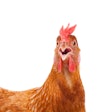
A cognitive supply chain could simplify and solve challenges in the poultry industry, from logistics to sustainability to optimizing feed formulations.
“Big data tells you where you have a problem. If you’re a farmer, it might say this field is too dry, but it’s always using analytics to tell you the problem. It’s also actionable because it asks you to go and do something,” Anthony Howcroft, CEO, SWARM Engineering, explained.
“That’s good on one level because it highlights problems. But on another level, we thought what if we could solve the problem instead of just telling someone they had one?”
What is cognitive computing?
Cognitive computing makes use of big data, artificial intelligence (AI), the Internet of Things (IoT) and other underlying technologies to enhance the human thought process to make decisions in complex situations.
The IBM Watson supercomputer is an example of cognitive computing.
“The model is very flexible. You can create your own templates, you can adjust them, or simply complete them,” said Howcroft. “It’s a whole bunch of questions and you just fill in the blanks.”
This helps create a narrow definition of the problem that needs fixing, giving cognitive computing the data it needs to produce a solution.
Cognitive computing in the poultry supply chain
Cognitive computing has several potential applications throughout the poultry supply chain.
For example, the technology can calculate the most efficient and cost-effective way to ship eggs or other poultry products from the processing plant to retail or foodservice.
In one example, costs associated with trucks and transportation were believed to be the challenge, but cognitive computing revealed that the real issue was that the trucks were being underloaded. The technology provided a recommended pallet loading plan without the need for spreadsheets or manual calculations.
“If you’re looking at the supply chain, there’s always conflicting objectives because you’re balancing how fast to get it to someone versus the cost versus the carbon output,” Howcroft said. “That’s hard for people to solve, but much easier for cognitive computing.”
The same technology could also help determine and optimize poultry feed formulations and maximize sustainable operations.


















